Growing Camellia in Australia is astonishingly easy, with its native habitat just a little further North there’s only one big difference in homegrown camellia to the famous Sri Lankan tea plantations.
Camellia is a beautiful glossy leaved evergreen plant with colourful flowers that bloom reliably every year, and while it might be a bit of a traditional choice for the garden, camellia’s timeless beauty has somehow forgone gardening fashions and remained desirable in gardens right through history.
More...
Camellia Plant Details

While Camellia sinensis is the most famous camellia, the camellias we grow in our gardens now are mostly Camellia japonica. Camellia sinensis is used to make tea across the world.
Using its young leaves, rich in bitter tannins, to brew up perfect cups of tea, and while you can make tea from any camellia, they never quite match up in flavour to Sinensis.
Camellias are native to South-East Asia but have natural variations in every corner of the Asian continent. It belongs to Theaceae, the tea family of plants, and a relative to Gordonia.
As a result, they enjoy high temperatures and high rainfall, but to get the best results we actually need to tweak their positions a little bit in cultivation to make the most of their glorious flowers.
Camellia Growing Habits
All camellias grow to around 2m tall in the right conditions and can cope with hard pruning as they do grow from old wood. Mature camellia bushes have a height and spread of roughly 2x2m.
Camellia thrives in partial shade and is fully frost tolerant so can be kept outdoors all winter. Due to its easy-going nature, it’s happy in pots but prefers being in well-drained ericaceous soil.
We’ll explore camellia soil requirements in more detail later in the article.
Best Camellia Varieties to Grow in Australia
Which camellia is right for you? Well, it depends on a few factors, but ultimately you can make any camellia work in almost any garden, as long as you’re prepared to find the right conditions for it.
Below we’ve compiled the best camellias to grow in Australia, but don’t let that limit your imagination!
1. Camellia japonica ‘Debutante’
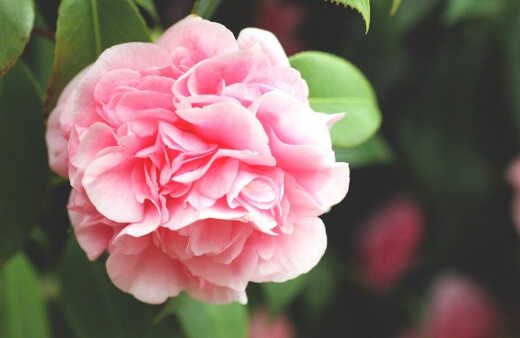
Camellia japonica ‘Debutante’ is one of the most popular camellias in cultivation. It's gorgeous peachy-pink double blooms can flower from late-autumn to early-spring, making them a perfect choice for gardeners in Australia trying to boost colour in colder months.
While the flowers aren't great for pollinators thanks to their tight double peony blooms they do offer some access to nectar in winter which is rare for flowering shrubs, especially to find winter flowering shrubs with such a reliably long flowering season.
2. Camellia japonica ‘Pink Perfection’

Camellia japonica ‘Pink Perfection’ is a gorgeous camellia, with flowers that mimic the mindful symmetry of lotus blooms. Their geometric lobed petals are the picture of perfection, usually flowering in late winter as the days begin to lengthen.


Get Your Free Guide:
Master Growing Australian Natives eBook
A Must Have Complete Guide for Every Australian Garden
Get Your Free Guide:
Master Growing Australian Natives eBook
A Must Have Complete Guide for Every Australian Garden
Again, like Camellia ‘Debutante’, the tight flowers aren't great for pollinating insects, but Pink Perfect are particularly good at attracting hummingbirds.
3. Camellia sasanqua ‘Yuletide’
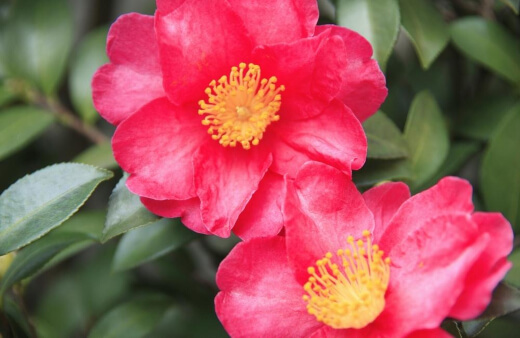
Camellia sasanqua are less popular shrubs than C. japonica because their flowers are, admittedly, more boring, with a single layer of petals more akin to lose poppy flowers than tightly wound peonies.
But their more open flowers have a gentler kind of beauty that helps to naturalise the garden as well as helping pollinating insects in the depths of winter when few other plants are flowering.
Camellia sasanqua ‘Yuletide’ are also a particularly good camellia to grow in pots and containers. They are fast growing but don't mind being slightly restricted so will work well in small gardens in whatever sized pot you have space for.
4. Camellia sasanqua ‘Moonshadow’

Source: Greenleafnursery.com
Camellia sasanqua ‘Moonshadow’ is the best of C. japonica and C. sasanqua rolled together in one plant, with all the decorative qualities of the double flowered japonica varieties while retaining open blooms that allow pollinators to feed in the winter.
Their petals fade from pale pink centres to saturated vermillion tips, all surrounding a bright yellow centre which attracts birds and insects to the garden in abundance.
Find out more about Camellia sasanqua here.
5. Camellia sinensis
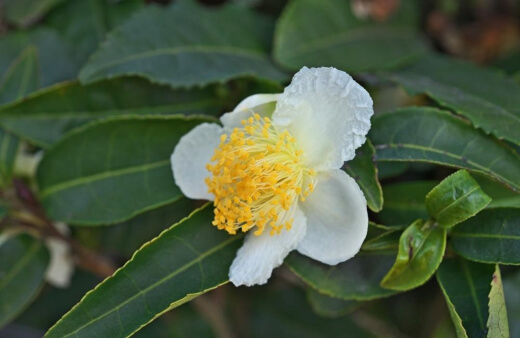
Unlike C. japonica or C. sasanqua, Camellia sinensis comes in just one variety. This is the tea plant, grown all over subtropical Asia, with higher sun tolerance, but with more watering needed than it's decorative cousins.
You can make tea with any young leaves from any camellia, but it's the early summer shoots of C. sinensis that works best, especially for growers in Australia.
While C. sinensis are grown for their leaves, they are also a really lovely garden shrub with delicate white flowers that are less dramatic than other camellias, but heavier in nectar.
Culinary Uses for Camellia
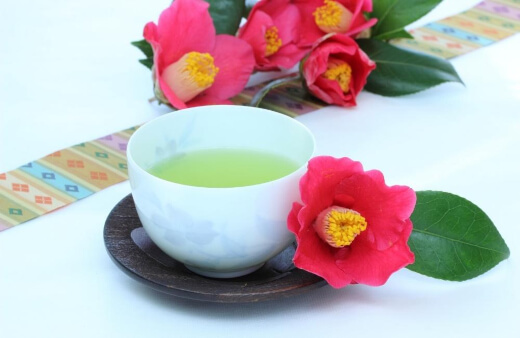
Mature Camellia sinensis can be used for tea production (a three-year-old camellia can be used for tea, but they are at their best when fully mature at around 2m tall).
For easy harvesting, try to keep camellia regularly pruned to around 1m so you can harvest without ladders. Start by pruning the plants in late winter, which promotes new foliage in spring, but will reduce flowering.
Small young leaves can be pinched out by hand in late spring, then simply placed on a drying rack on a kitchen windowsill or greenhouse. All the new leaves can be pruned and dried.
After a few days in full sun, the leaves should be a pale brown colour and slightly crisp with no moisture. These can be crushed and stored, or immediately used to brew homegrown tea.
How to Grow Camellia
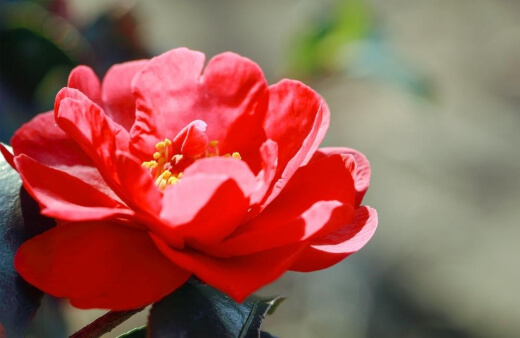
Propagating Camellia
Camellia can be propagated in almost every way under the sun, but by far the best way to propagate camellia is layering.
Let’s cover the basics though, and look at the different ways to propagate camellia so you can decide what’s best for you:
How to Propagate Camellia from Seeds
Camellia needs ericaceous soil at every stage of life, so because almost all seed compost is pH neutral, it’s best avoided for Camellia.
Camellia seeds are quite hard to germinate, and benefit from soaking overnight to soften their hard coat before planting - you can aid this further by sanding the dry seed shells slightly before soaking.
Plant in a 9cm pot filled with a 50:50 mix of ericaceous compost and vermiculite. Keep the soil damp by placing a plastic bag or cloche over the pot and storing it on a warm sunny windowsill.
The seed should start to germinate after one month, and once germinated can be grown-on anywhere over 18°C.
Grafting Camellia
Grafting is the most complicated way to propagate camellia, but they are much easier to graft than most other plants, as the selection of rootstock can be taken from the same plant, unlike fruit trees that require grafting onto alternative roots, so they’re a great plant for grafting newcomers.
Camellias grown from seed will flower around six years after planting, whereas grafted camellias flower after just 2 years. To graft a camellia, dig out a strong shoot from the ground that’s around half an inch thick, with decent roots.
These shoots are common with camellia and referred to as ‘volunteers’ (where roots send out surprise new plants from the roots of the original plant).
Cut the young camellia plant to 2” above the soil level; cut a v shape in the tip; then cut a corresponding point at the end of a cutting taken from the top of the mature plant; attach them together with tight twine, and keep them well watered.
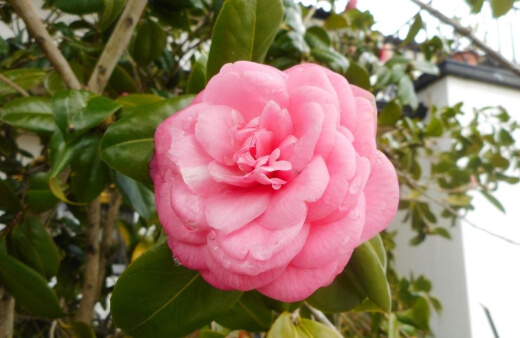
Semi-Ripe Camellia Cuttings
Semi ripe camellia cuttings are taken from any camellia growth from the previous year. Young camellia stalks are usually quite supple, and bend easily, but are not as delicate as new growth.
Semi-ripe cuttings should be taken in late spring or early summer from the previous year’s growth before they shoot out into new branches.
To take semi-ripe camellia cuttings, choose any stem with at least three pairs of leaves. Cut it with clean secateurs and place it immediately in water to prevent it from drying out.
Cut off the top two sets of leaves, dip the cut end of the cutting in rooting hormone or rooting powder (powder is preferable as the smell is less offensive) and plant in loose ericaceous compost with plenty of vermiculite.
You can also propagate cuttings in water but will need to place them in cutting compost anyway when they produce roots. It saves time but not effort.
Hard-Wood Camellia Cuttings
Hard-wood camellia cuttings should be taken in late autumn and will root and start to grow by early spring. They are taken from the previous year’s growth which has begun to form bark, but not completely wooden. Other than that, it’s the same process as semi-ripe cuttings.
Layering Camellia
Layering camellia is the easiest way to create new plants. Like many evergreen shrubs, branches low to the ground can simply be pinned to the soil with tent pegs, and slightly covered with compost at their mid-point.
The point that the branch touches the soil will send out new roots. After twelve months, gently pull the plant and check if it’s started to root (you should feel resistance, but don’t tug).
When it’s begun to root, cut it away from the parent plant and leave it in position for another season. After two years you should have a healthy young camellia plant that will flower in a few years’ time.
Caring for Camellia

Mulch & Soil
Camellia requires ericaceous compost for the higher acidity, which helps them process the iron they need for healthy growth. Camellias grown in alkaline or even neutral soils will quickly develop pale rusty coloured leaves.
Mulch camellia plants annually or biannually in spring to help them retain moisture with well-rotted manure to a depth of 1” in pots, or 2-3” inches for camellias planted in the ground.
Best Fertiliser to Use
Camellia is best fertilised by mulching (see our comprehensive mulching guide here), rather than any particular pouring feed, but it does benefit from old tea bags, which help to boost acidity in the soil.
Obviously, if you’re harvesting your own tea from the camellia this is a great way to reduce food waste by putting the leftover tea leaves straight back on the ground beneath your plants.
If you suspect an iron deficiency in your camellia due to poor soil, you can buy fertilisers with higher iron contents, but it should be naturally present in manure and most ericaceous composts in trace elements.
Watering Camellia
If, like me, you grow your camellia in a pot it will need regular watering and should never be allowed to completely dry out. They are reasonably drought tolerant but will start to show signs of under-watering pretty quickly in pots.
Thankfully, an under-watered camellia is easy to revive. Just prune off any leaves that have dried off, and soak the compost beneath the camellia.
Add an extra layer of mulch (don’t let it touch the main trunk if mulching in summer) which will help stop the water from evaporating away.
Pruning Camellia
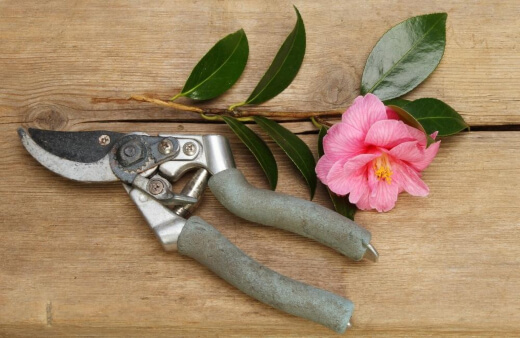
Camellia Japonica is particularly easy to prune, but every camellia will grow back from old wood. When you hard-prune a camellia, it can take two years to re-flower but it will give you a much better shape and tighter canopy.
To maintain the shape of a camellia, simply prune back the previous year’s growth every two years to two buds behind the newest leaf. (Need new secateurs? Check our reviews)
Light Requirements
Camellias are from cooler, wetter, climates than Australia, so need a little bit of balance when it comes to light and water. For example, their native Sri Lanka has around 2m of rainfall per year, whereas most of Australia has just 0.5m.
As a result, you need to plant camellia in part shade so it can cope with temperatures that can be up to 5o warmer than their natural habitat in summer.
Common Camellia Pests and Diseases
Camellia is unlikely to suffer from any sort of devastating pest infestation, but unhealthy camellias will host aphids and scales if they are too dry. The easiest way to prevent camellia pests is by watering them more often, but even well-watered camellia can suffer from caterpillars in Australia.
There’s not much you can do organically, other than pick caterpillars off your camellia. When it comes to diseases though, there are actually quite a lot of issues your plants can face, but again, the easiest way to prevent it is not to over-water camellias.
For camellias growing outdoors in Australia, you're unlikely to suffer from over-humidifying, but nevertheless, diseases can still be spread by insects and stick to wet leaves regardless of temperatures.
Camellia Bud Drop
Add nitrogen to your feeding routine to help improve plant resilience, but most cases of bud drop are caused by climate change as spring and autumn temperatures are warmer and more erratic which causes the plant to start growing too early and fatigued buds drop before they are able to flower.
Camellia Canker
Camellia canker is caused by branches rubbing together and dirty tools, but can also be the result of accidental damage or pest damage.
Essentially, bacteria gets into the stems and branches of camellia and you’ll notice a softening, darker, section of stem. You need to cut this off, and everything above it as it will not resolve, and it will spread.
Camellia Oedema, Leaf Gall, Botrytis & Sooty Mould
To prevent camellia oedema, leaf gal, botrytis and sooty mould, avoid over-watering or wetting leaves, and prune out any dead, damaged or diseased materials.
Prune old wood to try to open up the shape and improve air circulation in mature camellia that can hold humidity inside the plant’s outer canopy.
Camellia Frequently Asked Questions
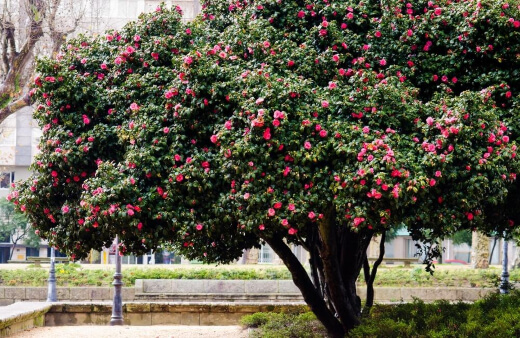
Do camellias prefer full sun or shade?
Camellias prefer shade but are happy in almost every location. To get the most out of your camellia flowers, plant them in spring in part-shade and keep them well watered for at least the first two years while their roots establish in their new location.
Is camellia a fast-growing plant?
Camellias grow a maximum of 6” per year in perfect conditions for the first few years after planting, but when they establish, they can grow up to 12” per year so are far from the slow-growing plant they have a reputation for being.
Why is my camellia dropping its leaves?
Camellias don’t like to be in full sun unless they are very well watered, and this is the most common reason they drop their leaves. You will notice camellia leaves turning brown in summer before the drop, if you see this happening, either move the plant or increase watering.
Are coffee grounds good for camellias?
Used coffee grounds and tea leaves are a perfect fertiliser for camellia as they gently raise the soil pH in a much more natural way than shop-bought fertilisers.
Tea leaves are the best fertiliser for camellia but the acidity of coffee grounds is a good substitute if you’re not a big tea drinker.
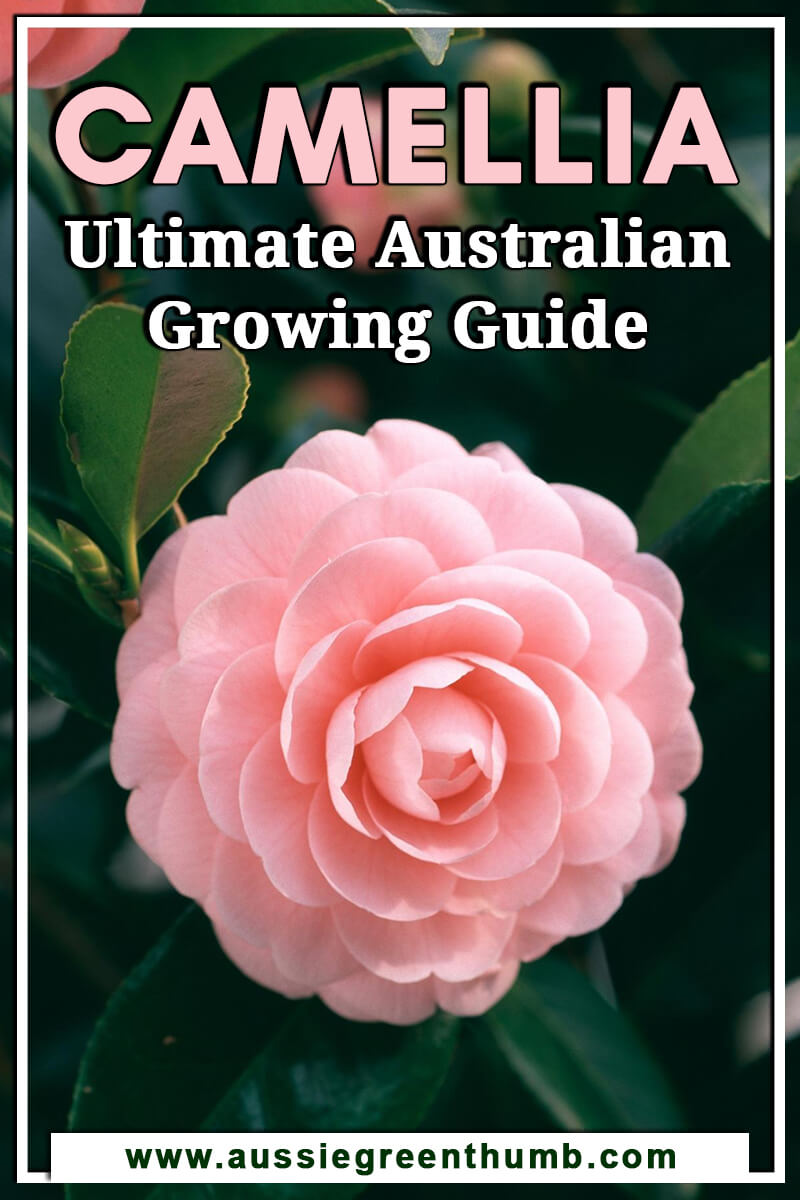
Add Timeless Beauty in Your Garden by Growing Camellias
There are few garden shrubs as dramatic as a camellia in full flower, and given how simple they are to keep happy it’s a perfect plant for any garden, with an incredible range of colours framed by deep, waxy, evergreen foliage.
If you ever need to troubleshoot camellia problems, or just need advice, remember we’re here, and come back for the best tips and advice for planting camellia in Australia whenever you need, from propagating camellia, to understanding its culinary uses.
Published on February 6, 2022 by Maisie Blevins
Last Updated on February 12, 2024





My camellia just does not seem to grow. Can I have petunias in the same pot. It is facing the east but only get early morning sun
Hi Carol,
The petunias won’t be causing any problems. Camellias are more than happy to compete with bedding. And in terms of position, Camellias are happy in full sun (but flower less), or part shade (but grow slower with more prolific flowers).
The most likely cause is time. How long has it been in the pot for? If it’s been in the same pot for more than five years it will be slowing down because any nutrients it had in the soil will be completely depleted. If it’s only just been planted, then it can take a year or two for it to get going.
I’d suggest feeding it in late spring, and again in autumn with pretty much any organic materials you can get your hands on. Rotted manure is best for camellias.
Also, a trick my grandmother used to do was to throw tea bags down at the base of her camellia. It’s a really gentle way to maintain light acidity in the soil, and makes good use of used tea bags too.
Best regards,
Maisie Blevins